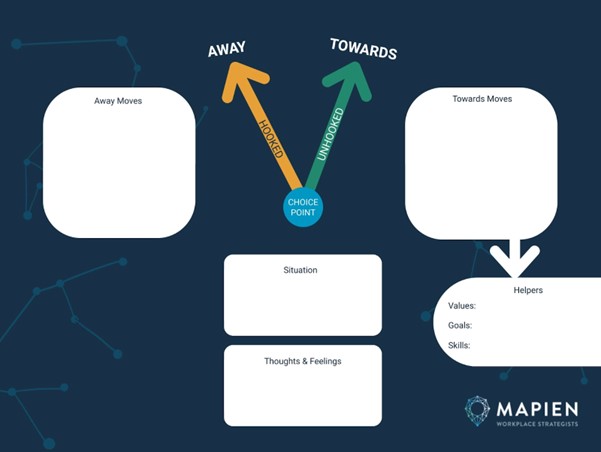
Using The Choice Point Method to Understand and Refine Behaviours
This is blog #4 in our series on coaching models. Sign up to our mailing list to make sure you don’t miss out on our future content.
Imagine this… you’ve got an important project coming up at work and if it goes well, you might be up for that promotion you’ve been hoping for. But instead of choosing to do the task, you spend the last few weeks working on just about anything but the project.
Even though the choice seems obvious and you know you should do the work, you just can’t seem to move forward. You’re stuck. And the longer you take to get started, the worse you feel, and the harder it is to get moving.
So, how do you get unstuck?
One of our favourite coaching models to help clients get unstuck from negative thoughts and behaviour patterns is the Choice Point Method. So, let’s take a closer look at this simple, but highly effective tool for self-reflection.
What is The Choice Point?
The Choice Point Method is a tool created by Joseph Ciarrochi, Ann Bailey, and Dr Russ Harris. They shared it in their popular book on using Acceptance and Commitment Therapy, The Weight Escape.
Choice Point is based on the following concepts:
- Values – Each person has values that are important to them within different contexts, and living and acting in alignment with those values will lead to a rich and meaningful life
- Towards Moves – In any situation, a person may act in a way that moves towards their values (these actions tend to be easy enough when life is going smoothly)
- Away Moves – In any situation, a person may move away from their values, the life they want, or the person they want to be (this tends to happen more often when life gets challenging)
- Thoughts & Feelings – Whether a person chooses to moves towards or away from their values is influenced by their thoughts and feelings within the situation
- The Choice Point – A person is required to make a choice when they experience challenging situations, feelings, and emotions
- Getting Hooked – Consistently choosing to make away moves tends to lead to greater distress and mood disturbances that can keep people hooked on these negative patterns of behaviour
- Getting Unhooked – By understanding what’s going on and building skills, people can get unhooked from thoughts and feelings that lead to poor choices and go back to making towards moves
By the way, in case you’re more of a visual learner, Dr Harris has a great youtube video explaining the Choice Point.
What is Acceptance and Commitment Theory?
Acceptance and Commitment Therapy (ACT) is a therapy approach commonly applied by psychologists, psychiatrists, counsellors, and coaches to help clients or patients become more self-aware so that they can become in control of their responses and act in a way that’s consistent with their values.
The Choice Point Method is a useful tool for working through the core processes of Acceptance and Commitment Theory — either with a coach or on your own.
Why the Choice Point Theory Works
“There is always a choice.”
Sometimes life will be smooth sailing — and you’ll probably find that making choices that lead to a full and meaningful life will come easily when things are going well.
But a lot of the time, challenges will present themselves and during those times, it can be easy to slide down the slippery slope of thoughts, patterns, and choices that will only make you worse off.
The Choice Point Theory works because it can help you disrupt those negative thoughts, patterns, and choices so that you can get back on track. And there’s real proof of its effectiveness, too.
One experiment looked at how the Choice Point could help in a residential substance use disorder setting. They found it lowered psychological inflexibility and raised values-based action and self-compassion over time, with gains maintained at follow up, suggesting long-term benefits.
6 Steps to Applying the Choice Point

To apply the Choice Point Model to a specific situation in your personal or work life, print or recreate the above template and work through the following steps.
Step 1: Identify Situation
Start by defining a difficult situation you’d like to work on. You can apply the Choice Point Theory to nearly any aspect of work or life. Here are a few example situations you could use it to unpack:
- Dissatisfaction with work-life balance
- Difficulty getting started on a work project
- Health/weight struggles
- Trouble getting along with a colleague
Whatever you’re focusing on, add this to the diagram under ‘situation’.
Step 2: Consider Thoughts and Emotions
Next, take notice of the thoughts and feelings that come up when you’re focused on that challenging situation. If it’s a challenging situation, you might find yourself thinking or feeling things like:
- I can’t do this
- Anxiety
- Anger
- Confusion
- Inadequacy
Whatever your thoughts and feelings, note these down in the template.
Step 3: Define Your ‘Away’ Moves
Now consider what actions you tend to take in response to the challenging situation (and thoughts and feelings that arise). Note down any choices that move you away from your values and goals — and feed your negative thoughts and feelings. Depending on the situation, you might find yourself:
- Delaying or avoiding the task
- Doing other tasks that aren’t as important
- Entering into conflict with others
- Behaving in unhealthy ways
Whatever your away moves might be, make sure you get specific about what you’re doing (or not doing).
Step 4: Define Your ‘Towards’ Moves
Now reflect on any actions you already take that move you towards your values and goals in the context of the situation. Some general examples of towards moves include:
- Doing the task
- Preparing yourself or your space for the task
- Accepting help
- Making a plan and setting aside time
- Telling someone what you plan to do
Again, make sure you get specific about the towards actions you’re taking.
Tip: If you’re guiding someone else through this coaching model, make sure that they define their own towards and away moves. Don’t put words in their mouth or argue for or against something. This is a self-reflection tool and the person working through it must explore their options for themselves (and may need to revisit it more than once as they learn what works and what doesn’t).
Step 5: Reflect On Your ‘Helpers’
Continue fleshing out The Choice Point Model by exploring the goals, values, and skills that underpin your actions. These will help motivate you to make positive choices (even when negative thoughts and feelings arise), and help you identify what you might need in order to be successful.
Your goals will depend on the situation, but they might include things like:
- Stopping something that you don’t want to do
- Starting something new and positive
- Doing well at work/school
- Building good relationships
- Achieving a specific milestone by a certain date
These goals will provide insights into what matters most to you — in other words, your values. When listing out your values, you might include things like always trying your best, making the most of your time, or having a positive impact on others.
Now, consider any skills you might need to build in order to unhook from those away behaviours and start making towards choices. For instance, you might need to work on your self-acceptance, empathy, goal-setting, communication, and scheduling, along with other practical or soft skills.
As with the other steps, make sure you get specific!
Step 6: Use the Insights to Make Conscious Choices
You might be surprised to see how much of a difference it can make once you see your subconscious thought processes (and resulting behaviours) mapped out on paper.
Use the insights from your completed Choice Point Method template to notice your thoughts and feelings in the moment so that you can make more conscious choices that propel you towards your goals and values.
And of course, you can repeat this process as many times as you like with different situations. You could also revisit the model with the same challenge several months down the track, and use it to reflect on how you went and what else you might need to change.
Tip: In the workplace, you could bring out the Choice Point at quarterly check-ins
Connect with us!
Looking for leadership coaching or hands-on help with more great tools like this one? Contact us today!

